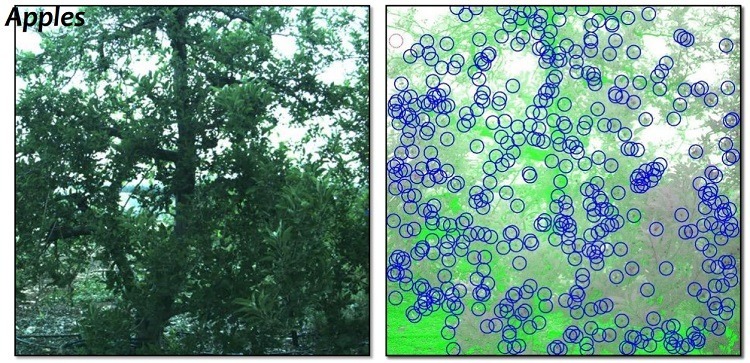Back in 2018, AFN highlighted the growing impact of hyperspectral imagery in agrifood tech as sensors get smaller, cheaper, and more precise.
This week, there’s another glimpse of that growth: The Israeli agritech company FruitSpec — which is carving out a niche using hyperpectral imagery to count fruits —is set to officially close its $4 million Series A fundraise at the Agrivest conference in Tel Aviv on Tuesday, AFN can reveal. Investors in the round include AgVentures, a South African agtech investment company springing from the private equity firm Acorn, and China’s Hubei Forbon Technology Co. Ltd (HFT). That all neatly tops up around $875,000 worth of seed funding from the Trendlines Group and the Israeli Innovation Authority.
I first heard an advanced snippet of this news on Monday on the sidelines of FoodTechIL, another cornerstone conference of Israel’s ongoing AgriFoodWeek. FruitSpec CEO Raviv Kula then confirmed it to me later in the day in an interview there while discussing his 12-person team’s technology. His team, he said, uses patented hyperspectral and computer vision algorithms. In other sectors, this sort of tech combination gets used for facial recognition, detecting cancer, or otherwise for broad military or aerospace purposes; but with FruitSpec, it is about a seemingly simple pursuit of counting up apples, limes, lemons, plums, or figs.
As my colleague Lauren Manning reported earlier this year, FruitSpec uses specially-designed sensor pods mounted on any vehicle that scan the trees in an orchard, effectively counting and map out the number of fruit still ripening up behind their leaves, as well as estimating fruit sizes. The aim is to accurately estimate early season fruit yields automatically.
Hyperspectral imaging technology is useful here, as it captures information from across the electromagnetic spectrum rather than only the visible light portion, the stuff which the human eye can see. Hyperspectral images combine the power of digital imaging with the chemical technique called spectroscopy. Differing objects reflect light in a specific way, generating unique spectral signatures which represent particular food characteristics. The piercing accuracy is breathtaking.
Accuracy matters a lot with high-value crops like apples. Not knowing your exact yields is a costly logistical nightmare and a recipe for food waste, Kula told AFN. “It’s like Amazon running their services without knowing their inventory.” Accurate manual counting of grapes, lemons, limes or peaches previously had to be done “through samples and extrapolation,” he says, noting how inaccurate this can be, and the difficulties even for people to tot up the numbers of figs in one tree if shrouded in leaves of a similar shade of green.
Michael Prinsloo of AgVentures, describing his decision to invest, seems to have bought into the importance of solid real-time fruit counting. It “seamlessly addresses a critical pain point within the fruit market value chain,” he writes in a statement sent to AFN, “and its value proposition is easily grasped by industry players. FruitSpec’s solution is not merely an incremental improvement to existing industry norms, but a total disruption of the inaccurate and labour-intensive methods currently used.”
Also at FoodTechIl, which is spearheaded by the Israeli conglomerate the Strauss Group, was AgVentures partner Gerhard Visagie, who also sat for interview to discuss the round’s due diligence: “We saw first hand what this solution provides to our own farms,” he said, describing how pilots and due diligence were done under his team’s watch in South Africa, and how they had been highly impressed with the results.
In all recent commercial operations and field trials, FruitSpec claims to have demonstrated accuracy rates above 95% with its technology (at an average of 97.3%). And Kula believes his team is positioned to have a major impact on the fruit yield estimation market, with a calculated 47 million hectares (116 million acres) of fruit orchards globally to aim for. This could translate, his team reckons, to a $3 billion market potential for FruitSpec. Kula also sees hope in updating his algorithms to include nut counting.
For FruitSpec’s Chinese investors, it is about assuring market access in China and using the company’s technology to ensure accurate market pricing.
“We strongly believe that FruitSpec’s technology and services will not only change the current practices in orchard management and logistics, but revolutionize them,” commented Renzong Wang, Chairman and CEO of HFT. He added, “given the fact that in China apples are already traded as a future commodity in the exchange market, and more agricultural produce will be listed in the near future, the information provided by FruitSpec will be invaluable for the participants in the market. We are anxiously anticipating FruitSpec’s entry into the huge Chinese market with our support, to serve all the stakeholders who will benefit from their services – growers, packing houses, logistics, and sellers.”
Have you spotted anything else on the move in the hyperspectral agritech space? Drop me a note at [email protected]




